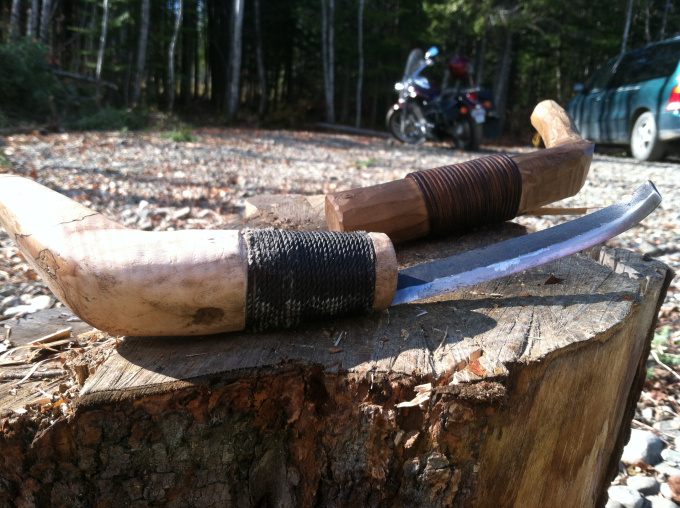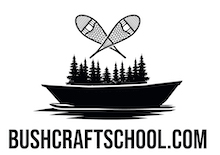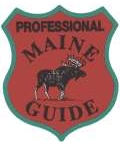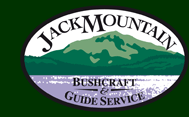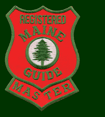It is amazing how many blogs, web sites and discussion forums are committed to outdoor knives. A cursory jaunt through the web will quickly inundate the reader in barrows of gigabytes covering every weekend warrior’s 2 cents on knife construction, design, material, use and even a slew of experts piping in to pitch their new knife that is now available at Wal-Mart for $29.95, plus tax. On the odd chance that there is any useful information to be found in this perplexing milieu, it is suffocated under the weight of sheer volume, kinda like the pea under a pile of mattresses.
Why all the hype with knives? As a full time wilderness guide and survival instructor I know the value of the knife I carry and I am always happy to help someone get a good knife in their hand. The image of a knife for some people stands for the rugged side of the wilderness, the authentic self- sufficient ubermensch of the American frontier. If manifest destiny was the motivation for westward expansion, the knife was the cutting edge of the frontier. Knives hold deep counsel in our American psyche; slaying Mammoths and fighting off the saber tooth with nothing more that a thin piece of metal between dinner and being dinner. Even though most modern people don’t slay anything more vicious than salami and cheese, we still identify with the image of a knife as courage, fortitude, visceral grunting and independence from the tyranny of the Wild.
Of all the tools I carry into the back country, my knife is top of the list; indispensable and indisputable as my greatest advantage over the cold, the darkness, and the boogy man. A knife can make fire, food, water, shelter, and medicine while also providing protection, if only in the form of courage. In skilled hands a knife is a game changer, but it is not the knife that makes the skill, it is the person that wields it. I’ve seen master fly casters throw a fly like a Jedi with old, broken rods and worn out fly line and I’ve also seen people decked out in $2000 worth of cutting edge gear struggle to get even 5 feet of fly line out on the river. I own a few expensive blades (that were gifts) which are truly works of art and I’m sure work well, but 365 days a year I use a decade old $15 knife for doing everything from felling any tree I can bend to gutting and skinning white tail deer to yes, cutting salami and cheese. Of course I don’t think I could do much with a butter knife, but more times than not I care less about what kind of knife I carry and more about how I can use it.
There are good knives out there for less than $20 that will serve you well for years and will stand up to a world of abuse. Then again there are $200 knives that will function the same but would you want to really put a $200 knife through the paces? A cutting edge becomes a personal item and what we chose is totally our choice, but if you are unsure of what you want in a knife here are a few ideas:
1. Think about what you are going to be cutting. A knife made to cut wood will look different from a knife made to cut meat. Knives that will be used for bushcraft- style work should have a design made for cutting wood, be strong enough to handle the forces of batoning and also hold an edge sharp enough to butcher game and carve detailed woodcraft projects. These knives typically have a blade of about 4-6 inches, or about the width of the palm of your hand and have a Scandinavian style bevel which is good for working in the northwoods of Scandinavian and North America. There are great knives that fit this bill for $15 and slightly better ones for $25. Of course if you live near the tropics maybe a chopping style knife would be better, but this is liable to turn into a 50 page book if we start going down that road.
2. The steel that makes the blade is like the steak in a steak dinner, sure the side vegetable and potato are important, but if the steak is a rubber tire the best veg and potato side will never make the world right. There is a scale to measure the hardness, which unless you’re a knife nerd or a knife maker it is really not that important. The steel should be hard enough to keep and edge but soft enough to take an edge. Many commercial blades are waaaaay to hard, so hard that they are impossible to sharpen and are actually brittle. There are typically two types of steel you’ll see: carbon and stainless steel. There are advantages to both, but it comes down to the hardness of the steel with carbon being sightly softer than the stainless. I know a lot of people who use both, I use carbon because I’m cheap and I can make enough sharpening kits for $20 to last me into the next century. Another plus for carbon is that you can throw a spark with a sharp piece of flint or other fine grained stone in order to make a fire. If you live near salt water maybe stainless would be a good choice.
3. Finger guards on a knife were designed for fighting, so unless you plan on knife fighting in the future, I’d stay away from knives with finger guards.
4. Unless is it a hand made creation, any knife that has a gimmick like a hollow handle for storing your survival kit or a compass on the end cap of the handle should be avoided. If you’re gonna buy a knife buy a knife and not a carnival act.
5. Folding knives are convenient, and that’s about all I can say about them. I own a few for skinning animals, but that’s all I use them for because for 95% of the work I do in the woods they are dangerous and vulnerable to breakage. Succinctly: the folding mechanisms will eventually fail sending the blade onto the top of the index finger of your hand you hold the knife in. On the up side, the blade may not end up in your finger but if/when the hinge breaks you will no longer have a functional knife, which is worse than a cut on your finger if you live in the bush. A fixed blade knife is safer and will be more functional for an afternoon or a life in the woods.
The best advice it to learn how to use whatever you buy. In skilled hands any knife is functional and that skill only comes through practice. There are many woodcraft and bushcraft courses available around the country which would be a good place to start learning to use your new knife. A good school should teach you how to safely use your knife and also how to maintain and care for than tool so it’ll last you a lifetime.
Read more along these lines: Bushcraft Knife Hype
